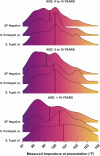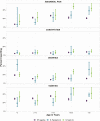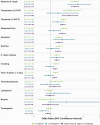Diagnostic Value of Clinical Features to Distinguish Enteric Fever From Other Febrile Illnesses in Bangladesh, Nepal, and Pakistan
- PMID: 33258936
- PMCID: PMC7705879
- DOI: 10.1093/cid/ciaa1297
Diagnostic Value of Clinical Features to Distinguish Enteric Fever From Other Febrile Illnesses in Bangladesh, Nepal, and Pakistan
Abstract
Background: Enteric fever, a bacterial infection caused by Salmonella enterica serotypes Typhi and Paratyphi A, frequently presents as a nonlocalizing febrile illness that is difficult to distinguish from other infectious causes of fever. Blood culture is not widely available in endemic settings and, even when available, results can take up to 5 days. We evaluated the diagnostic performance of clinical features, including both reported symptoms and clinical signs, of enteric fever among patients participating in the Surveillance for Enteric Fever in Asia Project (SEAP), a 3-year surveillance study in Bangladesh, Nepal, and Pakistan.
Methods: Outpatients presenting with ≥3 consecutive days of reported fever and inpatients with clinically suspected enteric fever from all 6 SEAP study hospitals were eligible to participate. We evaluated the diagnostic performance of select clinical features against blood culture results among outpatients using mixed-effect regression models with a random effect for study site hospital. We also compared the clinical features of S. Typhi to S. Paratyphi A among both outpatients and inpatients.
Results: We enrolled 20 899 outpatients, of whom 2116 (10.1%) had positive blood cultures for S. Typhi and 297 (1.4%) had positive cultures for S. Paratyphi A. The sensitivity of absence of cough was the highest among all evaluated features, at 65.5% (95% confidence interval [CI], 55.0-74.7), followed by measured fever at presentation at 59.0% (95% CI, 51.6-65.9) and being unable to complete normal activities for 3 or more days at 51.0% (95% CI, 23.8-77.6). A combined case definition of 3 or more consecutive days of reported fever and 1 or more of the following (a) either the absence of cough, (b) fever at presentation, or (c) 3 or more consecutive days of being unable to conduct usual activity--yielded a sensitivity of 94.6% (95% CI, 93.4-95.5) and specificity of 13.6% (95% CI, 9.8-17.5).
Conclusions: Clinical features do not accurately distinguish blood culture-confirmed enteric fever from other febrile syndromes. Rapid, affordable, and accurate diagnostics are urgently needed, particularly in settings with limited or no blood culture capacity.
Keywords: Enteric fever; South Asia; clinical diagnosis; typhoid.
© The Author(s) 2020. Published by Oxford University Press for the Infectious Diseases Society of America.
Figures



Similar articles
-
Incidence of typhoid and paratyphoid fever in Bangladesh, Nepal, and Pakistan: results of the Surveillance for Enteric Fever in Asia Project.Lancet Glob Health. 2022 Jul;10(7):e978-e988. doi: 10.1016/S2214-109X(22)00119-X. Lancet Glob Health. 2022. PMID: 35714648 Free PMC article.
-
Antimicrobial Resistance in Typhoidal Salmonella: Surveillance for Enteric Fever in Asia Project, 2016-2019.Clin Infect Dis. 2020 Dec 1;71(Suppl 3):S276-S284. doi: 10.1093/cid/ciaa1323. Clin Infect Dis. 2020. PMID: 33258934 Free PMC article.
-
Burden of Ileal Perforations Among Surgical Patients Admitted in Tertiary Care Hospitals of Three Asian countries: Surveillance of Enteric Fever in Asia Project (SEAP), September 2016-September 2019.Clin Infect Dis. 2020 Dec 1;71(Suppl 3):S232-S238. doi: 10.1093/cid/ciaa1309. Clin Infect Dis. 2020. PMID: 33258928 Free PMC article.
-
Typhoid and paratyphoid fever: a clinical seminar.J Travel Med. 2021 Apr 14;28(3):taab012. doi: 10.1093/jtm/taab012. J Travel Med. 2021. PMID: 33550411 Review.
-
Kathmandu, Nepal: still an enteric fever capital of the world.J Infect Dev Ctries. 2008 Dec 1;2(6):461-5. doi: 10.3855/jidc.162. J Infect Dev Ctries. 2008. PMID: 19745524 Review.
Cited by
-
Introducing Typhoid Conjugate Vaccine in South Asia: Lessons From the Surveillance for Enteric Fever in Asia Project.Clin Infect Dis. 2020 Dec 1;71(Suppl 3):S191-S195. doi: 10.1093/cid/ciaa1296. Clin Infect Dis. 2020. PMID: 33258930 Free PMC article.
-
Evaluating the accuracy of Salmonella Typhi Hemolysin E and lipopolysaccharide IgA to discriminate enteric fever from other febrile illnesses in South Asia.medRxiv [Preprint]. 2025 Jun 22:2025.06.20.25329792. doi: 10.1101/2025.06.20.25329792. medRxiv. 2025. PMID: 40585162 Free PMC article. Preprint.
-
Spatial Heterogeneity of Enteric Fever in 2 Diverse Communities in Nepal.Clin Infect Dis. 2020 Dec 1;71(Suppl 3):S205-S213. doi: 10.1093/cid/ciaa1319. Clin Infect Dis. 2020. PMID: 33258932 Free PMC article.
-
Healthcare Utilization Patterns for Acute Febrile Illness in Bangladesh, Nepal, and Pakistan: Results from the Surveillance for Enteric Fever in Asia Project.Clin Infect Dis. 2020 Dec 1;71(Suppl 3):S248-S256. doi: 10.1093/cid/ciaa1321. Clin Infect Dis. 2020. PMID: 33258937 Free PMC article.
-
Typhoid fever.Nat Rev Dis Primers. 2023 Dec 14;9(1):71. doi: 10.1038/s41572-023-00480-z. Nat Rev Dis Primers. 2023. PMID: 38097589 Review.
References
-
- Hippocrates. The genuine works of Hippocrates. London: Sydenham Society, 1849.
-
- Cunha BA. Osler on typhoid fever: differentiating typhoid from typhus and malaria. Infect Dis Clin North Am 2004; 18:111–25. - PubMed
-
- Willis T. Practice of physick. London, United Kingdom: Basset, 1684.

